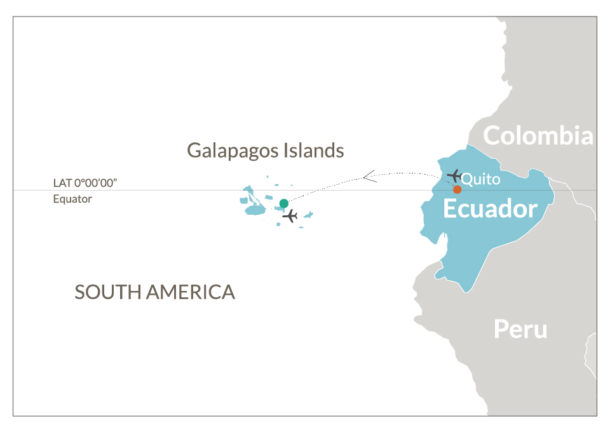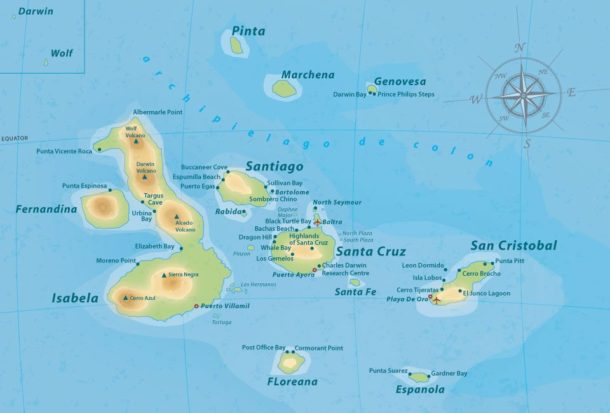Planning a trip to the Galápagos Islands? We don’t blame you, there are many reasons why the Galápagos regularly tops lists of people’s dream holiday destinations. With the unparalleled beauty of its natural landscapes, magnificent wildlife, world-class dive sites, and adventure activities, the Galápagos Islands truly have something for everyone.
The following blog will provide some facts regarding the archipelago’s geographic location, how to get there, and, finally, some must-see sights.
While you’re here, be sure to check out Academy Bay Diving’s Galápagos Islands Tour Packages and Galápagos Diving Trips and Courses.

Where Are the Galapagos Islands?
The Galápagos Archipelago is part of the country of Ecuador and is situated 906km (563 miles) off the coast of the South American continent in the Pacific ocean. The islands straddle the equator and cover an area of approximately 45,000 square kilometers (17,000 square miles), comprising 19 islands and hundreds of islets and rocks.
Volcán Wolf (the highest point at 1,707m above sea level) and Volcán Ecuador on Isla Isabela are directly on the equator. Española Island, the southernmost islet of the archipelago, and Darwin Island, the northernmost islet, are spread out over a distance of 220 kilometers.
The 5 inhabited islands are Isabela, the most extensive, measuring 5,827 km2 and making up almost three-quarters of the total land area of the Galápagos, Santa Cruz, the most populous, San Cristobal, the home to the Galapagos capital, and Floreana, with the smallest population of approx. 200 people. The fifth island is Baltra which has an airport, tourism dock, fuel containment, and military facilities.

The archipelago is located on the Nazca Plate (a tectonic plate). Also, it sits atop the Galápagos hotspot, where the Earth’s crust is being melted from below by a mantle plume creating volcanoes. The first islands formed here at least 8 million and possibly up to 90 million years ago, the oldest islands having already disappeared below the sea. In contrast, the youngest islands, Isabela and Fernandina, are still being formed.
Most of the islands represent the summit of a volcano, some of which rise over 3,000 meters from the Pacific floor. The larger islands typically comprise one or more gently sloping shield volcanoes, culminating in collapsed craters or calderas. Long stretches of shoreline are only slightly eroded. In many places faulting and marine erosion have produced cliffs and lava, coral or shell sand beaches. Other features include crater lakes, fumaroles, lava tubes, sulfur fields, and a great variety of lava and other ejects such as pumice, ash, and tuff.
With Academy Bay Diving’s Galápagos Diving Packages, you can see the archipelago’s dramatic underwater world and get up close to a variety of marvelous creatures, such as hammerhead sharks and manta rays.

Take a land tour to Bartolome
Now You Know Where They Are…How Do You Get to the Galápagos Islands?!
There are no direct international flights into the islands, but domestic flights originate in Quito, Guayaquil, and a new route, Manta. People traveling from Europe will generally fly from Madrid or Amsterdam directly into Ecuador, while people coming from the UK now have a direct flight into Colombia, with a connection to Ecuador.
Coming from the US, most flights have a stopover in Miami, giving you an excellent opportunity to extend your vacation, warm up along the way and explore a bit of Florida and Key West by boat.
Due to flight arrival times in Ecuador, most travelers will need to spend a night in mainland Ecuador and take an early flight to the islands the following day. Please ask us for advice any time with your airport transfers, hotel bookings, and even city tours and day trips to surrounding areas like Cotopaxi, Otavalo market, The center of the World, or Mindo Cloud Forrest if you would like to spend a few days getting to know these cities also.
(Our Where Are the Best Places to Visit in Ecuador? May provide some inspiration before you make the trip.)
If you are looking for another island adventure after your Galapagos trip, why not head to the Greek islands? We recommend a Drive Safari on Rhodes!
Some Unforgettable Things to Do in the Galápagos
- Encounter Giant Tortoises: Get up close to these ancient, gentle giants! When people think of the Galápagos, Charles Darwin and his famed expedition on The Beagle will often come to mind. Well, as you look into the face of one of these beautiful creatures at the Charles Darwin Research Station, you’ll get a new understanding of just how incredible it must have been for those early explorers of the island’s flora and fauna.
- Dive With Sharks: Of all the fantastic aquatic creatures we regularly encounter on our Galápagos Diving Trips, there’s none more beloved among our guests than hammerhead sharks. Learn more about which creatures you will see when exploring the Best Galápagos Dive Sites with Academy Bay Diving.
Elsewhere you can meet marine Iguanas (found only here) and swim alongside a veritable menagerie of fascinating species. Read about the wildlife of the islands on our Galápagos Wildlife page.
- Enjoy the Cultural Life of the Galápagos Islands: Only 25,000 people are resident across the entire Galápagos Archipelago, though you’ll find plenty of cultural diversity across the four inhabited islands of Isabela, Santa Cruz, Floreana, and San Cristobal.
From fresh lobster to seafood tacos and ceviche, we recommend you explore the cuisine during your stay in the Galápagos. Head to Puerto Ayora in Santa Cruz, and you’ll find a wealth of culinary delights awaiting you.
What are you waiting for? Begin planning the trip of a lifetime today! Explore the Academy Bay Diving website for Galápagos guidance, tips, and inspiration. If you have any questions, please get in touch.






